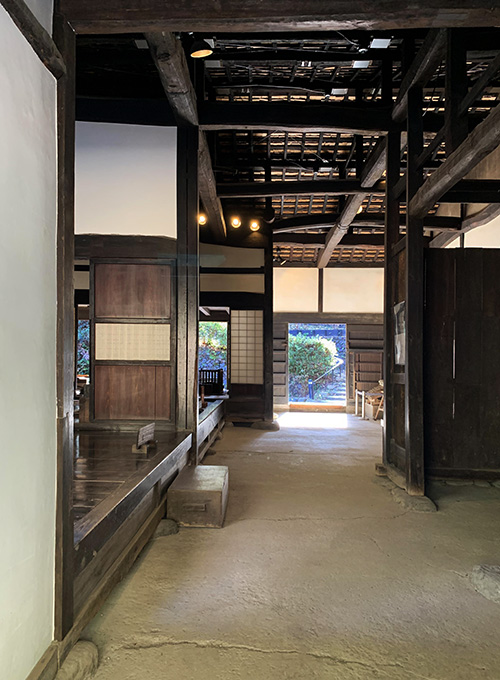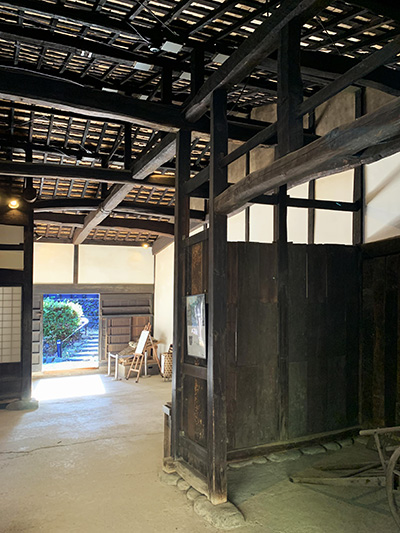

前回の「日本人のいい家」シリーズ⑯では奈良の町家商家の土間を見たけれど、
江戸期から残ってきている住宅はほぼ「生業」のための土間空間を持っている。
というか、明治開拓の北海道屯田兵屋でも室内空間の1/3程度は土間。
さらに言えば「麒麟がくる」建築時代考証担当の広島大学三浦正幸先生によると
戦国期、庶民住宅で木組みで床上げされた住宅はほぼありえなく、
土座でムシロなどの敷き込みが一般的だったとされています。
庶民の住宅は基本的に土間がメインで、ようやく江戸期になって
床上げされるようになったとされていました。
土間では農家であれば農家の必須作業仕事が行われ、町家にあっては
それぞれの生業の生産行為が「工場」として利用されてきたのが庶民の暮らし。
日本人は屋根のある作業場としての土間空間でいのちを繋いできたといえる。
住宅と生業の密接な機縁は、土間でながく伝承されてきたのだ。
わたしたち庶民が木の床やタタミの間に居住できたのは4−500年程度ということ。
よく「敷居が高い」というコトバがあるけれど、
それはただ単に玄関の敷居を指すのではなく、土間面から1段上がった床が
庶民に根付いてからそれほど歴史時間が経っていないことを表している。
であればDNAレベルの体験知にはなっていない可能性が高い。
この土座からの床上げの「ミッシングリンク」発掘は手掛かりが求めにくい。
けれど地道に探究し続けたいと思っています。

この長野・伊那の旧三澤家住宅は、大農家であり、
小作たちからのコメなどの生産品を毎年秋には受領してきた。
写真2番目の土間を通って、建物奥の「庭空間」に建てられた倉に収納した。
そのコメは牛車に乗せてこの土間を通り抜けたのだという家系伝承。
土間に面して「オオエ」と呼ばれる主居住室があって、三澤家当主が検分したか。
土間に対して「敷居」は高く造作され、天井は小屋組まで吹き抜けている。
大農家と小作との関係がどのようであったか、
一様に言うことはできないと思うけれど、三澤家の場合を考えてみると、
この三澤家は薬剤製造で財を成して6万坪にもなる農地を取得したと言われるので
基本的にはビジネスライクな関係ではなかったかと推測される。
小作にして見ると、銭の力で自らの支配権を獲得した経済合理性による「主人」。
奴隷労働を強いられるというような関係ではなかったのではないか。
この三澤家は大農家として、その先の権力機構に対して納税負担を行った。
納税という権力と民衆の一種の「契約関係」について、
共産党のイデオローグでもあった網野善彦氏ですら日本ではこの基本についての
民衆反抗の例は見られないと言われている。
そういう意味では、日本人は筋の明確な関係への拝跪には従順といえる。
土地所有と耕作権は別物と考えて、商的合理性への信頼は存在した。
大部分の小作農は、このように考えていただろうと推測できる。
三澤家は薬業経営が基本の「商家」であって、その利潤から大農家身分を購入した。
この江戸期末期建設の大農家住宅の土間・居宅空間から
権力と納税、小作の支配と「士農工商」身分制の実態が垣間見える思い。
The English version is here. ⬇
[Nagano / Ina Old House Doma / Living Room / Good Japanese House ⑰-3]
Missing link between the dirt floor and the floor. Establishment of large land ownership and large farmer by a pharmaceutical merchant. The actual situation of the Edo social division system.・ ・ ・
In the previous “Japanese Good House” series ⑯, I saw the dirt floor of a Machiya merchant house in Nara.
Most of the houses that have remained since the Edo period have a dirt floor space for “living”.
In fact, even in Tondenhei, Hokkaido, which was pioneered in the Meiji era, about 1/3 of the indoor space is soil.
Furthermore, according to Professor Masayuki Miura of Hiroshima University, who is in charge of architectural era examination of “Kirin ga Kuru”
During the Warring States period, it was almost impossible for a common house to have a wooden floor raised.
It is said that it was common to lay straw mats on the ground floor.
Most of the common people’s houses are basically in the dirt floor, and finally in the Edo period.
It was said that the floor was raised.
In the soil, if you are a farmer, the essential work of the farmer is done, and if you are in a townhouse
It is the lives of ordinary people that the production activities of each livelihood have been used as “factories”.
It can be said that the Japanese have connected their lives in the dirt floor space as a work place with a roof.
The close relationship between housing and livelihood has been handed down in the soil for a long time.
It is about 4-500 years that we, the common people, have been able to live between wooden floors and tatami mats.
There is often a saying that “the threshold is high”, but
It doesn’t just point to the threshold of the entrance, but the floor that rises one step from the dirt floor.
It shows that it has not been so long since it took root in the common people.
If so, it is highly possible that the experience is not at the DNA level.
It is difficult to find a clue to excavate the floor-raising “missing link” from this earthen seat.
However, I would like to continue my quest.
This former Misawa family house in Nagano and Ina is a large farmhouse,
We receive rice and other products from peasants every fall.
It was stored in a storehouse built in the “garden space” at the back of the building through the second dirt floor in the photo.
It is a family tradition that the rice was put on a cow car and passed through this dirt floor.
Did the head of the Misawa family inspect the main residence room called “Oe” facing the dirt floor?
The “sill” is built high relative to the dirt floor, and the ceiling is open to the hut.
What was the relationship between large farmers and tenants?
I don’t think it can be said uniformly, but considering the case of the Misawa family,
It is said that the Misawa family made a fortune in drug manufacturing and acquired a farmland of 60,000 tsubo.
It is presumed that it was basically a business-like relationship.
Looking at it as a peasant, it is the “master” of economic rationality who gained control of himself with the power of money.
Wasn’t it a relationship that forced slave labor?
As a large farmer, the Misawa family paid taxes to the power organization beyond that.
About the power of tax payment and a kind of “contractual relationship” of the people
Even Yoshihiko Amino, who was also the ideology of the Communist Party, is about this basic in Japan.
It is said that there are no examples of popular rebellion.
In that sense, the Japanese are obedient to worshiping a clear relationship.
There was confidence in commercial rationality, considering land ownership and cultivation rights as different things.
It can be inferred that most peasants would have thought this way.
The Misawa family is a “merchant” whose basic business is pharmaceutical business, and purchased the status of a large farmer from the profit.
From the dirt floor and living space of this large farmhouse constructed at the end of the Edo period
I think I can get a glimpse of the actual situation of power and tax payment, control of tenants, and the “Four occupations” status system.
Posted on 1月 11th, 2021 by 三木 奎吾
Filed under: 住宅マーケティング, 日本社会・文化研究, 歴史探訪







コメントを投稿
「※誹謗中傷や、悪意のある書き込み、営利目的などのコメントを防ぐために、投稿された全てのコメントは一時的に保留されますのでご了承ください。」
You must be logged in to post a comment.